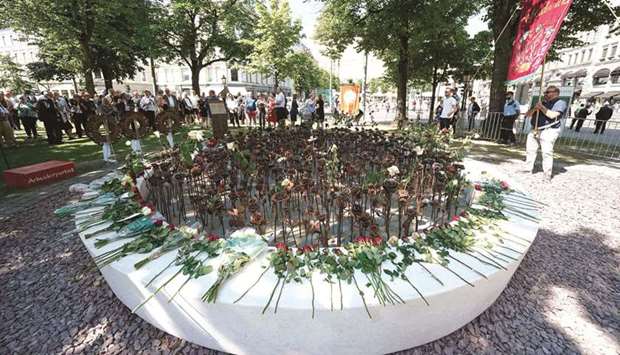Survivors of Norway’s worst massacre since World War II called yesterday for the country to stand up against the hatred that motivated right-wing extremist Anders Behring Breivik’s killing spree exactly 10 years ago.
Breivik set off a bomb outside the building housing the government’s office in Oslo killing eight people before shooting dozens at a summer camp organised by the Labour Party’s youth league (AUF) on the island of Utoya, leaving another 69 dead – most of them teenagers.
“July 22 was not a random act. It was not a natural disaster,” Astrid Eide Hoem, a survivor who has since become head of the AUF, said in a speech on Utoya yesterday. “It was a targeted political terror attack, driven by an extremist right-wing ideology. By hate.”
“Ten years later, we need to speak the truth. We have not stopped the hate. Right-wing extremism is still alive,” she said. “The terrorist was one of us. But he does not define who we are – we do.”
The shootings on the island lasted 72 minutes, as Breivik stalked and shot panicked young people trapped on the tiny island.
Breivik later said he had aimed to stage “a fireworks display” to draw attention to a 1,500-page anti-immigrant, anti-Marxist screed he dubbed a “manifesto” targeting those he blamed for ushering in the multiculturalism he abhorred.
“Ten years ago we travelled to Utoya to change the world. But then our world was changed forever,” Eide Hoem said. “The deadly racism and right-wing extremism live among us. Hate has killed before and hate can kill again.”
The 26-year-old ended her speech with a call to action: “Now we must settle our accounts with racism and right-wing extremism. Every single day.”
She and other survivors feel that even 10 years on Norway has still not truly faced up to the ideology that drove Breivik.
Speaking to survivors and relatives of the victims at a morning ceremony near the government complex where Breivik detonated his 950kg homemade bomb, Prime Minister Erna Solberg urged empathy and tolerance.
“It hurts to think back to that dark day in July ten years ago. Today, we mourn together. Today, we remember the 77 that never came home,” Solberg said. “We must not let hate stand unopposed.”
Church bells nationwide rang out in honour of the victims just after midday.
Shortly after the attacks, North Atlantic Treaty Organisation (Nato) chief Jens Stoltenberg – who was Labour prime minister at the time – promised to respond with “more democracy” and “more humanity”.
“Ten years ago, we met hatred with love,” Stoltenberg said in a speech during a church memorial service yesterday. “But the hatred is still present.”
This week vandals scrawled “Breivik was right” on a memorial for Benjamin Hermansen, who was killed by neo-Nazis in 2001.
Stoltenberg also referenced the 2019 attempted attack by Philip Manshaus, who opened fire into a mosque on the outskirts of Oslo before being overpowered by worshippers.
The Norwegian intelligence service (PST) also warned this week the kind of ideas that drove the killings in 2011 were “still a driving force” for extremists at home and abroad.
“We must dare to talk about what happened even if it is uncomfortable,” Crown Prince Haakon told survivors and relatives of the victims sitting on the Utoya lawn in the afternoon sun.
Breivik, who is now aged 42, was sentenced to 21 years in prison but the sentence can be extended indefinitely.
Many of the survivors still suffer from psychological trauma, including post-traumatic stress, anxiety, depression and headaches, a recent paper by the Norwegian Centre for Violence and Traumatic Stress Studies found.
“When you’ve been through something like this, you don’t go back to being the person you were,” Eide Hoem told AFP in an interview. “I have trouble sleeping, I’m afraid, and I think I’ll have to live with this all my life.”

People gather outside Oslo’s Cathedral during a memorial service yesterday, 10 years after a right-wing extremist killed 77 people in twin attacks.
